- Submissions

Full Text
Environmental Analysis & Ecology Studies
Assessment of Housing Quality in Osun State, Nigeria
Owolabi Babatunde Oluwaseyi*
Department of Urban and Regional Planning, Nigeria
*Corresponding author: Owolabi Babatunde Oluwaseyi, Department of Urban and Regional Planning, Nigeria
Submission: December 03, 2018;Published: July 08, 2019

ISSN 2578-0336 Volume5 Issue5
Abstract
This study focused on housing quality in Osogbo Local Government with the aim to assess the quality of residential housing in Osogbo Local Government, with a view of suggesting a sustainable housing quality for the people therein. The study examined; housing conditions, in-house facilities situation, as well as the socio-economic status on housing quality among sample respondents in Osogbo Local Government. Both primary and secondary data were used. Quantitative as well as qualitative analysis were done.
A total number of 210 questionnaires were administered using multi-stage sampling. Systematic random sampling was employed in which the whole local government was stratified into fifteen (15) geo political wards namely; Ataoja “A”, Ataoja “B”, Ataoja “C”, Ataoja “D”, Ataoja “E”, Otun Jagun B, Alagbaa, Are-Ago, Jagun “A”, Jagun “B”, Baba Kekere, Otun Jagun “A”, Eketa, Otun Balogun “A” and Ekerin according to the documented planning board records. Out of these wards, twelve come under high density; two of these wards are medium density while the remaining one is low density.
Therefore, six (6) wards were selected at random, to give every ward and buildings equal chance to be selected. They are Ekerin, Ataoja “A”, Ataoja “B”, Ataoja “D”, Ataoja “E” and Baba Kekere, in each ward; the first building was sampled at random while the subsequent buildings were chosen systematically after every tenth (10th) building.
The study employed both descriptive and inferential statistics for analysis. For instance, charts, percentages, etc., were the descriptive statistics used while inferential statistics such as Likert scale was used to explain respondents’ perceptions of condition of houses sampled in the study area.
The result of the analysis, it was shown and clear that the quality of housing in Osogbo Local Government is not encouraging and this is due to the low level of income been earned by the inhabitants, the highest number of respondents falls within the income is 31%. The study therefore recommends the important way of improving housing quality in areas where there are dilapidated structures may involve the use of housing micro-finance which consist mainly of giving loans to low-income earners. And also both the state and local government should embark upon programmes that will encourage provision of social facilities. This should include pipe-borne water, public toilet facilities, and effective waste disposal system.
Keywords: Assessment; Housing; Quality; Ondo state; Nigeria
Introduction
In recent times, there has been a growing concern in the deteriorating state of housing in most urban areas of the developing nations. Housing is one of the basic necessities of life; everyone wants to have a place of abode which is very conducive and suitable for human habitation. Housing is defined as “The process of providing a large number of residential buildings on a permanent basis with adequate physical infrastructure and social amenities, (Services) in planned, decent, safe, and sanitary neighbourhoods to meet the basic and special needs of the population” (Federal Ministry of Work and Housing, 2002 in Kuroshi and Bala, 2005).
It is defined by Onyike as “The process of providing a large number of residential buildings on a permanent basis with adequate physical infrastructure and social amenities, (Services) in planned, decent, safe, and sanitary neighbourhoods to meet the basic and special needs of the population”. Adequate housing should provide protection from the weather elements, and contribute to the physical, mental and social well being of the occupants. Consequently, housing has been described in various ways as follows:
According to the United Nations Centre for Human Settlement (HABITAT), adequate housing is defined broadly more than having a roof over one’s head. It implies protection from disposal of household and human wastes, sufficient spaces for health and privacy, security of tenure of occupancy, availability of safe drinking water, affordability and access to employment, health, recreation and educational services. It is important to note that as comprehensive as the definition of adequate housing by UNCHS (HABITAT) is adequacy of housing is essentially a national concept. U.N. declares the first Monday of October every year as WORLD HABITAT DAY. On this day, it is expected that everyone reflects on the housing problems all over the world and ponder over possible ways of solving these problems with the aim of housing the homeless and ensuring healthy and decent housing for those living in sub-standard places.
United Nations defines housing as which encompasses all the ancillary services and community facilities which are necessary to human wellbeing. Another author defined housing as “A complex package of goods and services and access to employment and community facilities” (PRC [Nig] Ltd., 1980).
On the other hand a decent housing must including not only a physically sound structure for shelter at affordable price but also at a suitable size and location which meet the needs of the household and a functioning neighbourhood environment with adequate supply of housing related services. Oluwande listed at least four conditions which must be satisfied before we have a decent, safe and habitable housing. These are; Physiology needs i.e. the housing environment particularly, the house must provide adequate privacy, clean, air, adequate natural and artificial light, adequate space for playing and outdoor living.
Psychological needs i.e. the housing environment particularly, the house must provide adequate opportunity for normal family and community life, easy movement within the house, proper maintenance and cleanliness.
Protection against accidents i.e. the housing environment particularly, the house must be properly constructed to prevent fire accidents, protection against electricity defects and gas poison, injuries at home and traffic hazards Protection against diseases i.e. the housing environment particularly, the house must give protection against diseases through provision of pure water supply, toilet facilities and sleeping spaces.
Housing quality has to do with the physical conditions of the housing units in a particular area in terms of their structural soundness or fitness, ventilation, natural and artificial lighting as well as essential facilities such as water, electricity, telephone services, toilet, bathroom, kitchen among others. In summary, housing quality refers to bundle of services which the house offers or is expected to offer to the household – such as shelter, independence, privacy status (including tenure), and comfort (i.e. accessibility to supporting services, facilities and utilities, convenience, safety and healthy environment).
Housing quality is determined by the maintenance culture of the residents as regards the existing housing unit. This is because if the existing facilities are maintained properly, the quality of housing will be very high.
Poor quality of housing environment: if housing is a totality of the environment within which the physical structure (shelter) is located, then the occupants of a house require and will make use of other elements in the immediate and general environment. Such elements include access roads, places of work and worship, shopping, recreational, educational institutions, health facilities and other community services.
Good quality housing provides the foundation for stable communities and social inclusion, therefore is essential to planning. It does not only ensure the safety and wellbeing of people, but promotes beauty, convenience and aesthetics in the overall built-up environment.
Housing Quality problems in Osogbo Local Government which is the main focus of this study is qualitative and quantitative in nature and must be looked into so as to ensure maximum satisfaction of individuals. The act of providing shelter for inhabitants can be a step towards making life worth living and other features surrounding them. Hence, there is need to study the quality of dwellings in Osogbo Local Government in order to establish different types of dwellings that exist in the study area as well as their quality.
Statement of the Problem
Historically, urban centre have been the driving force in economic, transport and social development. The benefit of urban centre are not solely economic, it is also associated with improved quality of life, improved health and higher literacy. Abiodun [1]. There is no country in the world which is devoid of housing problem; the problems of housing are much more acute in the developing countries than in the more developed nations.
In Nigeria, for example the increasing pace of urbanization and the high tempo of rural-urban migration makes housing problems in cities and towns very acute. Available evidence shows that many Nigerians do not have access to good shelter or decent homes. Abiodun [1] noted that the housing need in Nigeria urban centres has been made greater and housing problems exacerbates by a combination of factors. The bulk of housing units available in our urban centres mainly in dilapidated conditions and they are hardly suitable for habitation. Secondly, more houses are needed to relieve existing overcrowding in many of the Nigeria urban centres. Thirdly, natural increases within the urban centre demand additional dwelling units to house the increasing population. In terms of quantitative housing needs, the estimates of housing needs and demands in Nigerian urban centers are very staggering.
The consequences of adaptation and restructuring have resulted into differential housing quality in different communities. This problem of differential housing quality is compounded by the very rapid urban growth. The world is increasingly becoming urbanized and the rate at which city populations grow and countries urbanize is indicative of the pace of social and economic change. Since man’s quest for change will continue within his dynamic environment, this points to the fact that urbanization becomes an inevitable phenomenon particularly in developing countries [2].
The housing situation in Nigeria is very critical in urban centres and this is reflected in high house rent, increasing occupancy ratio, excessively high density of population ratio and encroachment of open spaces. The problems are reflected in the poor quality of housing units and inadequate infrastructural facilities such as roads, drainage, water, electricity supply etc.
The result of housing problems in Nigeria is manifested in growing overcrowding in houses, increasing pressure on infrastructural facilities and rapidly deteriorating environments [3].
Aim and Objectives of the Study
Aim
These study aim to assess the quality of residential housing in Osogbo Local Government, with a view of suggesting a sustainable housing quality for the people therein.
Objectives
In order to achieve the above aim, the following objectives are to;
A. Assess the quality of residential buildings in the study area.
B. Examine the socio-economic characteristics of the inhabitants in Osogbo Local Government Area.
C. Identify the problems associated with quality of housing in the study area.
D. Provide possible suggestions or recommendations on how to improve the quality of housing in the study area. Justification of the study
After food, Shelter has been accepted worldwide as the second most important essential human need. Meeting this essential need of people is one of the biggest challenges facing government worldwide. To meet these challenges, government and his agencies have contributed to put wide varieties of housing delivery options which include site and services scheme, modifications of land use and building regulations, employment and income generating programs for the poor to increase their ability to pay for housing among others [4].
In spite of all these, attempt has not been made to meet the challenges faced by the people of Osogbo Local Government on housing quality problem. However, this study seeks to give a clearer view on the quality of available houses in the study area and how these qualities can be improved upon through suggestions and recommendations in order to stress its importance to the current situation of the area [5].
Scope of the study
The research is concerned with studying the housing quality in Osogbo Local Government, in a clearer way, revealing situation in the study area as well as its implication for policy framework. Housing quality in this study will be studied within the context of in-house and around the house or outdoor environments [6]. Thus, reflecting the totality of the housing environment of the inhabitants in the study area. Detailed analysis of air quality and water quality will not assessed and analyzed as these may require further research and specific concentration.
However, a general observation based on the residents and researcher’s perceptions, and inferences drawn from other environmental indicators are enough to determine the nature of air and water pollution.
Some problems encountered during the field survey is the nonavailability of the total number of buildings in the study from the CENSUS office. During the course of the research work, the result of the total number of buildings had not be released to each local government, it was only the total population that was released to each state, therefore the buildings had to be enumerated or counted one by one in the study area [7].
In the administration of questionnaires, some of the local inhabitants were reluctant in disclosing their income, age, and in answering the questions concerning finance. Some respondents also show much reluctance in disclosing the number of people living together in a household. This however, has to do with the traditional belief among the Yoruba that it is forbidden to count the number of offspring to outsiders. It was also difficult to obtain the exact age of buildings from the respondents and these were estimated through memorable past events [8].
The study area
Osogbo the study area for this research is the capital city of Osun State. It is situated between Latitudes 7º42¹N and 7º51¹N and Longitudes 4º28¹E and 4º40E, with an average height of about 300 meters above the sea level. It was founded in the late 18th century and originated as a traditional as well as cultural town which derives its name from the proclamation by the goddess of Osun River. The town is known for very rich arts & cultural heritage. Following the creation of Osun State in 1991, Osogbo assumed the status of a state capital. It has two local governments which are Osogbo & Olorunda. It is a vast area with an extent in excess of 4700 hectares with an existing thickly populated urban area. Based on the 2006 population Census (provisional result) Osogbo has a population of about 156, 694 people, and the Postal Code of the area is 230 [9].
Over the years Osogbo has witnessed tremendous growth both spatially and in population. The establishment of a railway station is perhaps a major factor in the growth of Osogbo. Apart from the railway, postal & telecommunication [10], NEPA regional station, road network, agglomeration of heavy and many light industries, being the seat of government and the presence of a good number of higher institutions Osogbo thus became a major trading and distribution center for people within and outside its immediate environment.
In recent times, the location of Osogbo as a state capital coupled with other factors mentioned above has led to the influx of people from other towns and villages, thus giving it the status of a twin city, that is, a traditional as well as a modern city. This account for the uncoordinated expansion of the city which has posed serious consequences on land use planning and management [11].
Geo-Historical background of the study area
Osogbo was founded in the 18th century and originated as a traditional as well as cultural town which derives its name from the proclamation by the goddess of Osun River. Osogbo was created out of old Oyo state on august 27, 1991 by Babangida’s administration. It is a Yoruba town which is some 96 kilometer north-east of Ibadan, the capital of Oyo State [12].
The town is known for her very rich arts and cultural heritage. Following the creation of Osun State in 1991, Osogbo assumed the status of a State capital; it has two local governments which are Osogbo and Olorunda local government [13].
Osogbo is located on latitude 7.70N of the equator and longitude 4.50E of the Greenwich meridian. Osogbo falls within the climatic zone that can be described as the sub-equatorial region with two major season of the year. South westerlies bring Osogbo the study area for this research is the capital city of Osun State. It is situated between Latitudes 7º42¹N and 7º51¹N and Longitudes 4º28¹E and 4º40E, with an average height of about 300 meters above the sea level. It was founded in the late 18th century and originated as a traditional as well as cultural town which derives its name from the proclamation by the goddess of Osun River [14].
The town is known for very rich arts & cultural heritage. Following the creation of Osun State in 1991, Osogbo assumed the status of a state capital. It has two local governments which are Osogbo and Olorunda. It is a vast area with an extent in excess of 4700 hectares with an existing thickly populated urban area [15]. Based on the 2006 Population Census (provisional result) Osogbo has a population of about 156, 694 people, and the Postal Code of the area is 230.
Over the years Osogbo has witnessed tremendous growth both spatially and in population. The establishment of a railway station is perhaps a major factor in the growth of Osogbo. Apart from the railway, postal & telecommunication, NEPA regional station, road network, agglomeration of heavy and many light industries, being the seat of government and the presence of a good number of higher institutions Osogbo thus became a major trading and distribution centre for people within and outside its immediate environment [16].
In recent times, the location of Osogbo as a state capital coupled with other factors mentioned above has led to the influx of people from other towns and villages, thus giving it the status of a twin city, that is, a traditional as well as a modern city. This account for the uncoordinated expansion of the city which has posed serious consequences on land use planning and management. It rains in the west, while the north westerlies bring the harmattan (dry season). Osogbo has the mean annual temperature between 25.9 °C and 21.8 °C, the warmest month are February and march while the daily minimum temperature is recorded in January due to the influences of harmattan in august and September while December and January records little or no rainfall [17].
Osogbo is situated on a relatively flat surface area. The drainage system is influenced by the major river Osun that bisects the town; there are other tributaries like Okoko and Ogbagba that drain into Osun River. The topography of the town does not constitute any physical planning constraints.
Oshogbo the capital of Osun State had a population of about 251,674 in 1963; the national population commission 1991 provisional figures put it at 267,844. The town has an approximate total land area of about 1,495 kilometers before it was made the capital, but after it become the state capital the estimated total area was increased to 2,875 square kilometers [18]. This was done when the Osogbo capital territory was established in 1992 and declared all land within 15 kilometers radius to the center of the town as part of Osogbo.
The occupational structures of the people revealed that majority of the people are predominantly farmers and traders. Products cultivated are both cash crops such as cocoa, palm trees, kolanut, maize, yam, cassava among others. Migrant traders from other parts of Nigeria include Ife, Delta and Ekiti states influences the rapid flourishing of trading activities in the area. Other forms of occupation include artisanship, blacksmithing, dyeing pottery, sawmilling, public administration, service and repair industries. Osogbo being a traditional Yoruba city, exhibits the structure or plan of a typical Yoruba traditional city that can be approximated to model plan [19].
Climate
Osogbo has an average rainfall of 1150mm a year; it lasts from April to late October or early November, though it eases off in July or August. The dry season lasts from December to March which is the period of intense heat. It lies mainly in the deciduous forest area which spreads towards the grassland belt of Ikirun, north of Osogbo [20]. The climate is less humid and hot than the greater part of south-western Nigeria although the effect of the harmattan wind is strongly felt in the dry season. Osogbo is situated on a raised land which is well over 500 meters (800 feet) above the sea level and is drained by River Osun and its tributaries such as River Ogbaagba, River Gbodofon, River Okoroko (okooko), Olohunkoro, and other streams (http://www.osogbocity.com).
Geomorphology
The land is geologically made of Pre-Cambrian rocks, the Basement Complex from which the fairly fertile clayey loam soil of the surrounding district is derived [21].
Human Activities and Infrastructure
Osogbo became a commercial town with the arrival of railway in 1907 which brought the colonial government of then to the threshold of the town. The River Osun and its tributaries provide the early settlers with regular source of water supply and through its good drainage a good healthy physical area emerged for development purpose. Industrial and commercial development has always received adequate attention of the settlers and immigrants from other parts of the country. The busiest and most commercial parts of the town are Ayetoro area, Ajegunle area and the area along and around Station road [22].
Here almost all the ethnic groups in Nigeria are represented trading side by side in harmony; along these roads are the commercial firms and banks. The indigenes initially took to the cottage and handicraft industries such as dyeing, narrow-loom weaving, blacksmithing, pottery, embroidery and small scale farming. In addition Osogbo people are renowned, worldwide, for their unique creations of art works of different cadre; Painting, Carving, Bead-works, Sacred artworks and even performing arts. Need to say this ever-increasing fame in contemporary African arts has shot Osogbo to a prominent spot in the world map as far as Arts and Antiques collections is concerned [23].
The oldest industrial establishment was the defunct seed-cotton ginnery known and called the British Cotton Growers Association (B.C.G.A) near the Railway Station with capacity to produce 4,000 bales of ginned cotton per annum. The establishment wound up due to some reasons not unconnected with better skills of production. Agricultural, Commercial and Industrial Establishments is widely spread across the town, some of them include the TUNS farm, Lead pencil manufacturing Factory, Sawmills, the Nigerian Machine Tools, Osogbo Steel Rolling Company, Industrial Development Centre, Wire and Nails Industry, Printing Presses, Garment Industry, Canning factory, Sanitary Pad [24], Plastic pipes Factory, allied products and hotels (http://www.osogbocity.com).
The town became a tourist centre for her famous Osun festival celebration which attracts people from far and near places every year. With the enlistment of the Osun grove as a world heritage site by the United Nations Education Scientific and Cultural Organization (UNESCO) in 2005, the annual Osun-Osogbo festival which is celebrated in the last week of August of every year has received a boost from not only indigenes of the town but also the international community. (www.sunnewsonline.com/new/trending).
Research Methodology
Introduction
This chapter shows the presentation of various methodological approaches utilized in the course of the study; this chapter also includes the study population and its characteristics, the data needed, data gathering techniques and the methods of analysis as well as the presentation of data. Methodology was concerned with both the detailed research methods through which data was collected, and the general philosophies upon which the collection and analysis of data was based.
Data collection method
This research was also applicable to the notion that the authenticity of any research finding depends on the data collected in terms of questions posed and response gotten. The two sources of data which was also applicable to this project are;
A. Primary Sources and
B. Secondary Sources
Primary sources of data
The Primary Sources that were adopted in this research are;
Direct interview: Due to the nature of this research, a schedule of interview was conducted and this shall be used as a guide for inquiring about their housing conditions [25].
Observations: Some of the buildings were visited, thereby given an opportunity to have a verbal discussion with the residents of the dwellings in a bid to extract more valuable information from them.
Use of questionnaire: This was achieved through Questionnaire Administration. The Administration of the questionnaire was aimed at sourcing information on the quality of housing and well-being of the residents. This was necessary to ascertain their views, challenges and other necessary information which may be considered confidential [26].
The questionnaire was divided into five [5] sections, they include;
A. Socio-economic Background: This deals with the general information about each respondents; this involves the age, marital status, gender, educational background, occupation, income e.t.c.
B. Characteristics of Housing: This gives information on the housing type, ownership status and age of the buildings.
C. Structural Quality of the House: This gathered information on the building materials for construction, type of roof, floor type, and type of ceiling.
D. Facilities Available in the House: This shows the facilities available in the house such as lighting, source of water, power supply, type of toilet, cooking place, bathroom, e.t.c.
E. Environmental Management in the Study Area: This comprises the method of garbage collection, the distance travelled to dispose the waste and the effectiveness of the bodies responsible for the collection of refuse [27].
Secondary sources of data
This was done by consulting relevant text books, journals, previous researches, published work and other information obtained from town planning office at the local government headquarter. Maps were also used for illustrations [28].
Sampling techniques and sampling frame
For achieving the goal of this section, systematic random sampling was employed in which the whole local government was stratified into fifteen (15) geo political wards namely; Ataoja “A”, Ataoja “B”, Ataoja “C”, Ataoja “D”, Ataoja “E”, Otun Jagun B, Alagbaa, Are-Ago, Jagun “A”, Jagun “B”, Baba Kekere, Otun Jagun “A”, Eketa, Otun Balogun “A” and Ekerin according to the documented planning board records. Out of these wards, twelve come under high density; two of these wards are medium density while the remaining one is low density [29].
Therefore, six (6) wards were selected at random, to give every ward and buildings equal chance to be selected. They are Ekerin, Ataoja “A”, Ataoja “B”, Ataoja “D”, Ataoja “E” and Baba Kekere, in each ward; the first building was sampled at random while the subsequent buildings were chosen systematically after every tenth (10th) building [30].
Sample size
From the selected densities (3 densities from high; 2 density from medium; and 1 density from low); 10% of houses was randomly selected from each density. While the first building for questionnaire administration was randomly chosen, unit of investigation applied was ten - every tenth building; this was carried out to ensure that every building has equal chance of being selected and also the population figure for Osogbo Local Government according to the 1991 National Population Census was projected to 2014. This was done to have a reliable population figure to work with; using an annual growth rate of 3.2% (fraction at 0.032) derived from previous 2006 census figures for Osun state [31].
The 2018 population of the study was projected using this formula:
P = A(1+ R)n
Where,
P = Estimated Population
A = Existing Population
1 = Constant
N = Number of Year
R = Growth Rate (which is 3.2% derived from previous 2006 census figures for Osun state).
For this study, a total number of 210 questionnaires were administered in all the six (6) wards selected due to time constraint. The number of questionnaire administered in each ward was determined by: Projected population of each ward/total projected population of the six wards x total number of questionnaires.
Method of data analysis and presentation
Questionnaires were designed to include closed and open questions, in the structured questions, respondents supplied other answers in some cases where the pre-determined options on the body of the questionnaire was insufficient. After this data were sourced, several analytical techniques were employed in the analysis and presentation.
In analyzing the data collected from the field for this research, the information was processed from the questionnaire, summarized and presented in tabular forms. Descriptive statistical methods such as percentages, graphs and frequency tables were used for analyzing and presenting data percentages.
Other scientific method adopted for the analysis of the questionnaire was Likert scale [32].
Result of Findings
This chapter focuses on the analysis of data collected from the administration of 210 questionnaires in Osogbo Local Government and it is summarized with tables, figures and other scientific method.
In identifying the Residential Housing Quality in Osogbo Local Government, the following housing characteristics are used
General quality of housing in Osogbo
These give the general qualities of housing in Osogbo Local Government as a whole in respect to the Socio-economic Background, Characteristics of Housing, Structural Quality of Houses and the Facilities available in the House.
Socio-economic background of the people in Osogbo: The Socio-economic Background includes the Age of Respondent, Gender, Marital Status, Educational background, Occupation, the Level of Income and the Number of Household. The socio-economic background of people reflects to some extent the type and quality of houses that they live in. It also shows the general standard of living.
Age of respondents: Table 1 shows the age distribution of the respondents in the study area shows that people between the ages of 18-25yrs are 8%, 46-55yrs are 19.0%, 26-35yrs are 20%, while those between the ages of 36-45yrs and above 55yrs are 24% and 29% respectively. This means that majority of the respondents are aged people, therefore their inference about the physical quality are valid as they are matured and have seen it all, making them to have better perception of what affects them than the younger ones.
Table 1:Projected Polpulation for year 2018.
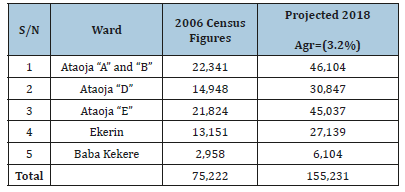
Source: NPC (2006), Computation, 2018.
Sex of respondents: Table 2 shows the data above revealed the socio-economic characteristics of the residents in the study area, 60.5% of the respondents were Male, while 39.5% were Female. Hence, this means that Males carry out the responsibility of Provision of Housing Quality and Facilities.
Table 2:Sample frame and sample size.

Source: NPC (2006), Computation, 2018.
Marital status of respondents: Table 3 shows that Married people dominated the sampled houses in Osogbo Local Government with a percentage of 66.7%, 19.0% were single, 12.4% were widowed, while 1.9% of the respondents were divorced. It could therefore be deduced from the gender and marital status that a higher percentage of married stay at home and were interviewed.
Table 3:Shows the breakdown of the sample size.

Source: Field Work 2018.
Educational status of respondents: Table 4 reveals the level of education as one of the variables used to assess the environment of the respondents revealed that respondents with non-formal education were 34.3%, primary education accounted for 26.2%, while tertiary and secondary were 23.3% and 16.2% respectively. As seen that respondents with non-formal education dominated the area hence accounted for some of the nonchalant attitudes of caring for the house quality. Unlike where we have people with least secondary school education or better still, with tertiary education that is expected to facilitate a quality house. Note that lack of education also causes poverty, so it has a chain effect.
Table 4:Age of respondents.
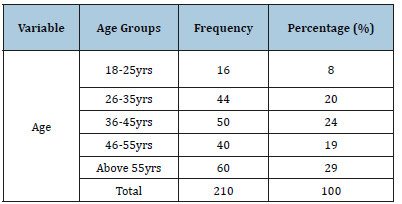
Source: Author’s field work, 2018.
Occupational status of respondents: Table 5 can be seen that people who are self-employed were 69 (32.8%) out of the whole lot of 210, following closely are traders who accounted 28.1%, although most of them are petty traders as they lack sufficient funds to make their businesses flourish. Next are the civil servants, students, unemployed, farmers and lastly the artisans who account for 14.3%, 7.6%, 6.7%, 6.2%, and 4.3% respectively. All these factors stated go a long way to determine the economic status of quality of housing.
Table 5:Sex of respondents.

Source: Author’s field work, 2018.
Monthly income of respondents: Table 6 shows the monthly income status of the residents in the study area that the highest number of respondents falls within the income bracket of ₦5,100- ₦10,000 which is 31%, with those between ₦10,100-₦20,000 following closely with 30%, while those that earn below ₦5000, between ₦21,000-₦40,000, and above ₦40,000 accounts for 28.6%, 8.1%, 2.3% respectively. This goes a long way to tell the high level of poverty in the study area. Hence the reason, a vast majority cannot afford decent quality house.
Table 6:Marital status.

Source: Author’s Field Work, 2018.
Showing number of household in Osogbo: Figure 1 shows the number of household in a particular building in the town. It is seen that a building with one household family takes the highest percentage of (42.4%), two household takes a percentage of (24.8%), three household has (11.0%), four household has (10.0%), five household have (7.1%) while six and seven household has (2.4%) and (1.9%). Buildings with ten household members have (5.0%).
Figure 1:Map of Nigeria showing Osun State. Source: Author’s Field work, 2018.
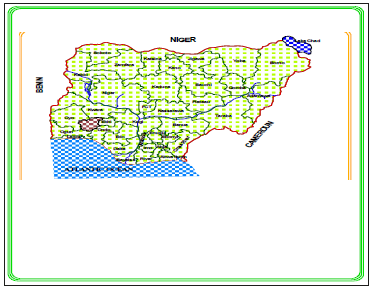
Use of buildings: Table 7 shows residential buildings are preponderant in the area with a rating of 54.8%, followed by mixed uses which accounts for 23.8%, next is commercial at 19.0% and lastly light industries 2.4%. Those buildings said to be of mixed uses are a combination of residential and commercial, with the commercial basically petty trading in front of buildings by housewives and the industrial are small scale industries such as bakeries, block industries.
Table 7:Level of education.

Source: Author’s field work, 2018.
Characteristics of housing in Osogbo
The characteristics of housing in Osogbo deals with the housing type, ownership status and the age of the building.
Housing type in Osogbo: Figure 2 shows that (29.0%) of the sampled houses in Osogbo are Storey building while Traditional Houses accounted for the second largest portion of (24.3%). Block of flat and Bungalow respectively has (22.4%) and (21.9%). There is (2.4%) of Duplex in the house which shows the least percentage in the type of house in the town.
Figure 2:Map of Osun State showing the study area. Source: Author’s Field work, 2018.

Ownership status of houses in Osogbo: Figure 3 shows the ownership status of houses in Osogbo. It could be seen from the sampled houses that owner occupier has the highest percentage with (53.3%) while family houses accounted for (23.8%). Rental and inherited respectively have (13.3%) and (9.5%). It can then be deduced that most of the inhabitants of the town are blessed with their buildings.
Figure 3:Shows the number of household. Source: Author’s Field Work, 2018.
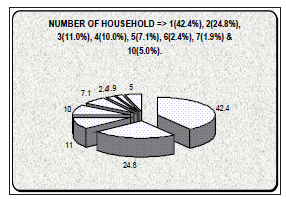
Age of buildings in the study area: Table 8 shows that buildings less than 10years claim 21.9%, those between the ages of 11-20years, 21-40years and above 40years claim 30%, 19.5%, and 28.6% respectively. This implies that most of the buildings in the study area have been built for over decades. Hence the reasons we have archaic looking houses and also contribute to degenerating state of quality therein.
Table 8:
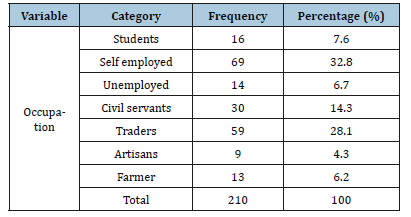
Source: Author’s field work, 2018
Structural quality of housing in Osogbo
The structural quality of houses in Osogbo includes the construction material of building, wall type, roof type, ceiling, floor types and the type of window. Table 9 shows that houses made of cement block dominates the study area with 61.9%, following closely are those built with mud/clay which accounts for 33.3%, and lastly are those built with concrete accounting for 4.8%.
Table 9:Monthly income.
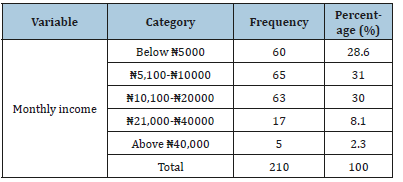
Source: Author’s field work, 2018.
Wall types of buildings in the area of study: Table 10 here, it is observed that houses with plastered wall accounts for 66.7%, while those that are not plastered are just 33.3%. Although the walls been plastered did not conceal the great deal of decadence of the structural wall quality of houses in the study area. It could also be attributed to the ages of the building.
Table 10:
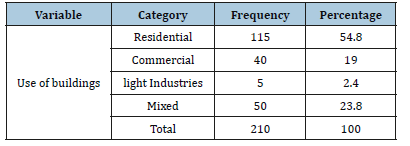
Source: Author’s Field Work, 2018.
Figure 4 shows that Iron sheet dominates the type of roof being used for houses in Osogbo with a percentage of (92.9%). Asbestos also takes a smaller percentage of (6.7%), while only few building is found with a concrete which has (0.5%).
Figure 4:Housing type. Source: Author’s Field Work, 2018.

Type of ceiling in Osogbo: Figure 5 shows the type of ceiling of the sampled houses in Osogbo. The most type of ceiling found is Asbestos with (66.2%) while Mat and Cardboard have a percentage of (21.9%) and (9.0%) respectively as ceiling type. However, it is seen that smaller percentage of houses are without any ceiling which has (2.9%). Figure 6 shows the type of floor. It is seen that (86.2%) of the buildings are floored with concrete while mud floor and concrete compact accounted for (1.9%) and (4.3%). Tiles have (7.6%).
Figure 5:A Traditional House at Isale Osun (high density area). Source: Author’s Field Work, 2018.

Figure 6:A Duplex at Oke-Ayepe (Low Density Area). Source: Author’s Field Work, 2018.
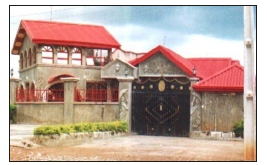
Types of window in Osogbo: Figure 7 shows the type of window. Louver has the highest percentage with (49.5%) followed by Wooden which has (37.6%). Slide glass has the minimum percentage with (12.9%).
Figure 7:A Storey building type at Odi-Olowo (Medium Density Area). Source: Author’s Field Work, 2018.

Condition of buildings in the study area: Table 11 The data reveals that the buildings in very good condition claim just 14.3%, buildings in good condition account for 19.0%, those that are fair, 42.9%, while those in poor condition accounts for a whopping 23.8%. This can be attributed to the old age of the buildings in question.
Table 11:The Age of buildings.
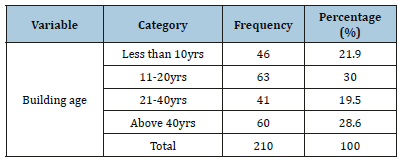
Source: Author’s Field Work, 2018
Building defects in the area of study: Table 12 reveals the building defects in the area of study, where the case of cracked walls accounts for 19.0%, for broken floors 19.5% responded in affirmative, sagging roof accounted for 14.3%, distressed windows rated 14.3%, leaking ceiling take 13.8%, while dilapidation accounted for 9.5%. All defects can be attributed to the age of the buildings and the income earned by the respondents as a vast majority are a little more than low income earners.
Table 12:Construction material of buildings in the study area.

Source: Author’s Field Work, 2018.
Facilities available in the house and surrounding in Osogbo
This shows the facilities available in the houses in Osogbo and they include the Accessibility, Drainage system, Lighting Type, Source of Water, Toilet, Cooking Place and Bathroom.
Accessibility to buildings in the study area: Table 13 shows that the area of study has majority of their roads tarred with a rating of 62.9%, the un-tarred roads coming up next with 23.8 %, buildings that are not accessible 3.8% and lastly those are only accessible via footpath 9.5%.
Table 13:Wall types of buildings in the area of study.

Source: Field work 2018.
Drainage type of buildings in the study area: Table 14 data further reveals the adequacy of drainage facilities showing the number of respondents with no drainage as 24.3%, those with open drainage rates 61.4%, while those with covered drainage accounted for 14.3%. From the statement above, there is cause to worry about the outbreak of diseases as we have more of open drainage, which breeds bacteria and viruses.
Table 14:Condition of buildings in the study area.

Source: Author’s field work, 2018.
Types of bathroom: Table 15 shows, the respondents have their bathrooms located outside their buildings as 28.6% indicated so. 59.5% of them have it located within their buildings, 9.5% do not have it at all while 2.4% gave no response and efforts ask them of where they have their baths proved futile.
Table 15:Building defects in the area of study.

Source: Author’s Field Work, 2018.
Figure 8:Shows the ownership status of houses in Osogbo. Source: Author’s Field Work, 2018.

Toilet system in Osogbo: Figure 8 shows the type of toilet used in Osogbo Local Government. From the figure, (50.0%) of the houses use Pit latrine while (41.4%) uses water system, (4.3%) uses public toilet while (4.3%) also have no toilet facilities.
Table 16 shows the cooking place in Osogbo Local Government that the percentage of those sharing kitchen with others is higher with (42.9%) while those using private kitchen is (28.6%). Those using house passage within the building have a percentage of (19.0%) while those using detached kitchen has the lowest percentage with (9.5%). The problem of theft of foodstuffs, cooked food and even kerosene has been a major complaint of cooking in the passage and detached. So, the safety of cooking is also in doubt as cooked foods are exposed to micro-organisms and other dangerous bacteria. Also, the emission of carbon from mostly those who make use of firewood is dangerous as it diffuses with the air breathe in by the respondents and also stains the walls of buildings.
Table 16:Accessibility to buildings in the study area.
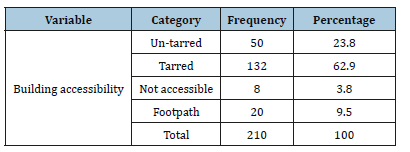
Source: Author’s field work, 2018
Water source in Osogbo: Figure 9-12 shows the Sources of Water in Osogbo. Water is no problem except in the dry season when a relative severe draught is felt. It could be seen from the figure. that both the tap water and well water sources has the same percentage which is (48.6%) and (48.6%) respectively, while, (2.9%) of the sampled building uses bore hole.
Figure 9:roof types in Osogbo. Source: Author’s Field Work, 2018.

Figure 10:Type of ceiling in Osogbo. Source: Author’s Field Work, 2018. FLOOR TYPE(MUD FLOOR => 1.9%, CONCRETE

Figure 11:The Type of Floor. Source: Author’s Field Work, 2018.

Figure 12:The type of Window. Source: Author’s Field Work, 2018.
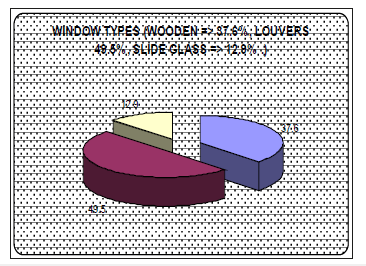
Frequency of water supply in the study area: Table 17 although, those who have access to borehole do not get it regularly as a result of the erratic power supply and as for the well water too, the regularity at which they have access depends on the season of the year. In the table above, 57.2% claimed that the frequency of supply is not regular. 41.4% deemed it to be regular while 1.4% gave no response (Figure 13).
Figure 13:Structurally and qualitatively deficient buildings, jumbled together in Isale Osun Area.

Table 17:Drainage type of buildings in the study area.

Source: Author’s Field Work, 2018.
Sources of energy in the area of study: Table 18 revealed that 65.7% of the respondents rely solely on electricity generated from the Power Holding Company of Nigeria, 15.2% make use of generating sets while 19.1% resort to other means such as traditional lamps, lanterns and so on as they are not connected to electricity.
Table 18:Types of bathroom.

Source: Author’s field work, 2018.
Frequency of power supply: Table 19 revealed that 71.9% of the respondents attested to not having regular power supply, while just a few 28.1% claimed it is regular. With the incidence of irregular power supply on the high side, so many activities are being crippled as they are mainly dependent on it. For instance, welders, people who sell ice drinks, tailors and the like complained about it as the irregularity reduces their efficiency. Although, the area is powered by the same source, but that did not affect the perception of some respondents as in the case of 28.1% who claimed it was regular. This could be attributed to their economic status and as to what use they put electricity (Figure 14).
Table 19:
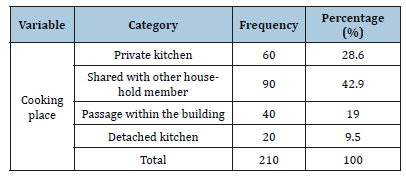
Source: Author’s Field Work, 2018.
Proximity of health centre: Table 20 shows that 19.5% of the respondents have to cover long distances to get to the nearest health centre, 54.8% accounts for those that do not travel too far, 20.9% claimed it is near them, while 4.8% do not have access to the health centre at all.
Table 20:Water supply.

Source: Author’s Field Work, 2018.
Parking space: Table 21 shows that on-street parking is preponderant in the area, rating at 59.4%, 28.6% of the respondents have their vehicles parked in the front of their buildings, 2.4% gave no response while 9.5% have theirs parked in the garage. Although, these so-called garages happened to be spaces inside fenced buildings with gates.
Table 21:Energy source.

Source: Author’s field work, 2018.
Figure 14:An outdoor bathroom in the area of study at Oja Oba. Source: Author’s Field Work, 2018.
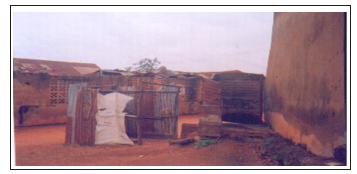
Recreational facilities: Table 22 shows that 47.6% of the respondents have to cover long distances to get to the nearest recreational facilities, 9.5 % accounts for those that do not travel too far, 2.4% claimed it is near them, while 40.5% say recreational facilities is not available.
Table 22:Sources of power supply.

Source: Author’s field work, 2018.
School facilities: Table 23 shows that 2.4% of the respondents have to cover long distances to get to the nearest school, 23.8% accounts for those that do not travel too far, 73.8% claimed it is near them.
Table 23:

Source: Author’s field work, 2018.
Market facilities: Table 24 shows that 2.9% of the respondents have to cover long distances to get to the nearest school, 22.3% accounts for those that do not travel too far, 74.8% claimed it is near them.
Table 24:Parking space.

Source: Author’s field work, 2018.
Environmental management in your neighbourhood
Mode of waste disposal of respondents in the area of study: Table 25 shows that the predominant mode of waste disposal is the refuse container which scores 47.6% which are usually provided by the state government located within the neighbourhood, 28.6% of the respondents dump their waste on lands which are usually vacant lands or uncompleted building located within the neighbourhood, 11.9% of the respondents make do with nearby bush, while 7.1% and 4.8% of the respondents disposes off their waste at the backyard and inside the drainage respectively (Figure 15).
Table 25:Recreation facilities.
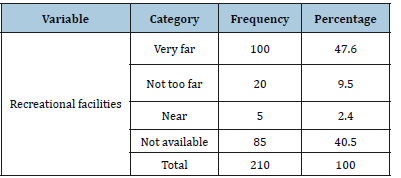
Source: Author’s field work, 2018.
Waste management techniques: Table 26 shows that 50% eradicates their waste by collection through government agent, 33.3% of the respondents admitted to tripping into the public refuse container provided by the government, while 7.1% tipped their into storm water drains, 4.8% of the respondent’s waste are collected by waste contractors and 4.8% find other technique alternative by eradicating their waste by burning which causes pollution to the environment and affected the ozone layer (Figure 16).
Table 26:School facilities.

Source: Author’s field work, 2018.
Figure 15:The Type of Toilet. Source: Author’s Field Work, 2018.
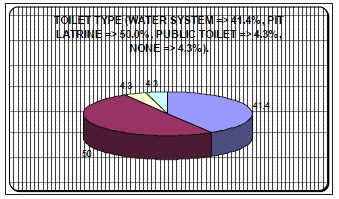
Figure 16:An outdoor Toilet in the Area of Study. Source: Author’s Field Work, 2018.

Key To abbreviations used
Using Likert scale, Table 27-31 Shows respondent perceptions on the condition of houses which is weighted and it was observed that roof, wall, floor and lightning are in a bad condition having its mean weighted value as 3.5 and 3.7 respectively. Other variables such as doors, windows, paints, staircase, toilet, bathroom and ceiling are weighted to be in fair and good condition. From the result acquired it can be derived that the overall housing condition in Osogbo is fair having its ΣMWV as 3.1.
Table 27:Market facilities.

Source: Author’s field work, 2018.
Table 28:Mode of waste disposal.

Source: Author’s field work, 2018.
Table 29:Waste disposal techniques.

Source: Author’s field work, 2018.
Table 30:Key to abbreviations used.

Table 31:Respondents’ perceptions of condition of houses.
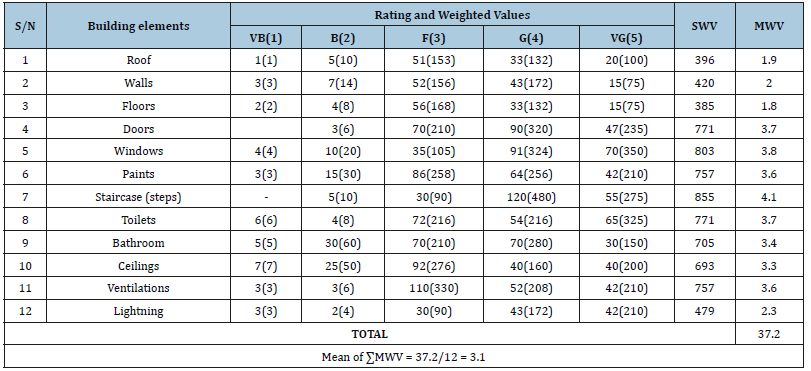
Source: Author’s field work, 2018
Summary of Findings, Recommendation and Conclusion
Introduction
This chapter gives the summary of analysis in the previous chapter. It also gives recommendations and conclusions for improving the standard and quality of houses in Osogbo Local Government.
Summary of findings
From the result of the analysis, it was shown and clear that the quality of housing in Osogbo Local Government is not encouraging and this is due to the low level of income been earned by the inhabitants, the highest number of respondents falls within the income, is 31% This goes a long way to tell the high level of poverty in the study area (Figure 17).
Figure 17:The Sources of Water in Osogbo. Source: Author’s Field Work, 2018.

Hence the reason, a vast majority cannot afford decent quality house. This was observed and based on the evaluation of the characteristics of houses in the Osogbo Local Government like the housing type, the structural quality of the houses like the type of wall materials and the roof type, also the facilities available in the house like the lighting type, toilet, cooking place, bathroom, and the garbage collection.
The analysis shows that majority of the respondents in Osogbo Local Government lives in traditional houses and storey building (24.3% and 29.0%) respectively. Majority 92.9% of the buildings uses Iron sheet as roof. Findings from the analysis also show that 57.2% claimed that the frequency of supply is not regular. 41.4% deemed it to be regular while 1.4% gave no response. It is also seen from analysis that most of the buildings are in high unsanitary condition. For instance, as high as 50.0% are still using pit latrines while 4.3% had no access to toilets.
Moreover, result from findings shows that the conditions in which the inhabitants are cooking are deteriorating. As high as 42.9% shared kitchen with other household member while 28.6%, 19.0% and 9.5% use private kitchen, passage within the building and detached kitchen. result from findings shows waste management techniques that 50% eradicates their waste by collection through government agent, 33.3% of the respondents admitted to tripping into the public refuse container provided by the government, while 7.1% tipped their into storm water drains, 4.8% of the respondent’s waste are collected by waste contractors and 4.8% find other technique alternative by eradicating their waste by burning which causes pollution to the environment and affected the ozone layer and also from the result acquired it can be derived that the overall housing condition in Osogbo is fair having its ΣMWV as 3.1.
Conclusion
Housing is one of the basic necessities of life; everyone wants to have a place of abode which is very conducive and suitable for human habitation. Housing quality has to do with the physical conditions of the housing units in a particular area in terms of their structural soundness or fitness, ventilation, natural and artificial lighting as well as essential facilities such as water, electricity, telephone services, toilet, bathroom, kitchen among others. In summary, housing quality refers to bundle of services which the house offers or is expected to offer to the household - such as shelter, independence, privacy status (including tenure), and comfort (i.e. accessibility to supporting services, facilities and utilities, convenience, safety and healthy environment).
Findings conducted in Osogbo Local Government shows that many houses are substandard; and this is due to the low level of Income been earned by the inhabitants. Facilities such as toilets, bathroom, and kitchens are inversely proportional to the number of people using them. Policy recommendations have been put forward such that if taken and implemented would alleviate the problems enumerated above. All these positive steps and many of such would go a long way in solving the qualitative housing problem in Osogbo Local Government. This would greatly improve the health and living condition of people in Osogbo Local Government and it’s environment.
Recommendation
Based on the summary of findings, the following suggestions and recommendations are made to improve the existing stock of housing quality and general development in Osogbo.
A. The important way of improving housing quality in areas where there are dilapidated structures may involve the use of housing micro-finance which consist mainly of giving loans to lowincome earners. The loans can be granted by Government Agencies, Credit Cooperatives, Non-Governmental Organizations with an urban poverty focus, and Micro-finance Institution and the loans will be repayable between 2-24 months for home improvement, and 2-5 years for land purchase of construction.
B. Town planning authority should be more efficient in its development control measures. They should ensure that plans conform with the planning principles before approval is made.
C. Both the state and the local government should embark upon programmes that will encourage the provision of social facilities in different areas. This should include among others pipe borne water, public toilet facilities and drainage system.
D. People should make sanitation part of their day to day activities and they should see their environment as a living organism which when altered will have a negative effect on them.
E. The government in collaboration with health council should provide dust - bins and organize adequate and effective waste disposal systems in different areas in Osogbo. A waste disposal board should be inaugurated and organized to educate and enlighten the public about the danger of unhealthy environment.
References
- Abiodun JO (1979) Housing Problem in Nigerian Cities. Town Planning Review.
- Agbola T (1998) The Housing of Nigerian: A review of policy development and Implementation. Research Report No. 14.
- Aribigbola A (2000) Conceptual issues in housing and housing provision in Nigeria. In: Baumol, Paulus PB (Eds.), Chapter 14: Crowding. Handbook of Environmental Psychology. Edited by Daniel Stokols and Irwin Altman 1: 533-570.
- Baumol MJ, William EO (1979) The theory of environmental policy. Prentice-Hall, USA.
- Bowen W (2002) An analytical review of environmental justice research: What do we really know? Environmental Management 29(1): 3-15.
- Effective Housing in the 21st Century. A publication of the Environmental Forum, School of Environmental Technology, FUTA, Nigeria, pp. 1-8.
- FGN (1991) National Housing Policy. Federal Ministry of Works and Housing, Lagos, Nigeria.
- Galster GC, Hesser GW (1981) Residential satisfaction: Compositional and contextual correlates. Environ Behav 13(6): 735-758.
- Gilbertson J, Green G, Ormandy D, Thomson H (2008) Good housing and good health? A review and recommendations for housing and health practitioners. A sector study housing corporation. UK.
- Housing policy formulation in developing countries: Evidence of Programme implementation from Akure, Ondo State, Nigeria. J Hum Ecol 23(2): 125-134.
- Merrill MD (1997) Instructional strategies that teach. CBT Solutions, pp. 1-11.
- Miles R (2005) Preventing asthma through housing interventions.
- Miles R (2005) Preventing asthma through housing interventions: How supportive is the US policy environment. Housing Studies 20(4): 589- 603.
- Miles R (2005) Smoking, housing conditions and respiratory health in the WHO-LARES. Proceedings of the 2nd WHO international housing and health symposium. Vilnius, Lithuania.
- Milstead, Terence, Miles, Rebecca (2005) Housing conditions, pest infestations and population health in the WHO-LARES. Proceedings of the 2nd WHO International Housing and Health Symposium, Vilnius, Lithuania.
- Milstead, Terence, Miles, Rebecca, Rebbel, et al. (2006) Housing and neighborhood conditions and exposure to cockroaches in the transitioning countries of eastern and Central Europe. Journal of Housing and the Built Environment 21: 397-411.
- Morshidi Sirat, Abdul Fatah Che Hamat, Abdul Rashid Abdul Aziz, Alip Rahim, Halim Salleh e al. (1999) Low-cost housing in urban-industrial centres of Malaysia: Issues and challenges. University Saints Malaysia Bookshop Ltd, Penang, Malaysia.
- Ogu VI (2002) Urban residential satisfaction and the planning implications in a developing world context: The example of benin city, Nigeria. International Planning Studies 7(1): 37-53.
- Oladapo AA (2006) A Study of tenant maintenance awareness, Responsibility and satisfaction in institutional housing in Nigeria. Vilnius Gediminas Technology University, Lithuania. Int J Strategic Prop Manage 10(4): 217-231.
- Oliver RL, DeSarbo WS (1988) Response determinants in satisfaction judgements. Journal of Consumer Research 14(4): 495-507.
- Oliver RL (1989) Processing of the satisfaction response in consumption: A suggested Framework and research propositions. Journal of Satisfaction, Dissatisfaction and Complaining Behavior 2: 1-16.
- Olotuah AO (2000) The challenge of housing in Nigeria. In: Akinbamijo OB, Fawehinmi AS, Ogunsemi DR, Olotuah A (Eds.), Effective Housing in the 21st Century Nigeria. The Environmental Forum, Federal University of Technology, Akure, Nigeria, pp. 16-21.
- Onibokun P (1974) Evaluating consumers’ satisfaction with housing; An application of a System Approach. Am Inst Planners J 40(3): 189-200.
- Parasuraman et al., 1985; 1986; 1988; 1990; 1991a; 1991b; 1993; 1994; Zeithaml et al., 1990; 1991; 1992; 1993) SERVQUAL: Review, critique, research agenda 30(1): 8-32.
- Perlin SA, Sexton K, Wong DWS (1999) An examination of race and poverty, pp. 1942-1949.
- Satsangi M, Kearns A (1992) The use and interpretation of tenant satisfaction surveys in British social housing. Environment and Planning 10(3): 317-331.
- So ATP, Leung AYT (2004) Survey of attitudes towards buildings in three Chinese cities: Hong Kong, Shanghai and Taipei. Facilities 22(3/4): 100- 108.
- (2004) Preventing Asthma through Housing Interventions: How supportive is the US Policy Environment? Housing Studies 20(4): 589- 603.
- Theodori GL (2001) Examining the effects of community satisfaction and attachment on individual Well-being. Rural Sociology 4(66): 618- 628.
- US Environmental Protection Agency (2007) Human health 47(4): 339- 347.
- World Health Organization Regional Office of Europe (2007) Housing and Health: The LARES project (Large Analysis and Review of European housing and health Status).
- Zeithaml, Parasuraman (1988) Service quality dimensions, Perceive Value and Zeithaml VA, Berry LL, Parasuraman A (1993) The nature and determinants of customer expectations of service. Journal of the Academy of Marketing Science 21(1): 1-12.
© 2019 Owolabi Babatunde Oluwaseyi. This is an open access article distributed under the terms of the Creative Commons Attribution License , which permits unrestricted use, distribution, and build upon your work non-commercially.
 a Creative Commons Attribution 4.0 International License. Based on a work at www.crimsonpublishers.com.
Best viewed in
a Creative Commons Attribution 4.0 International License. Based on a work at www.crimsonpublishers.com.
Best viewed in 







.jpg)






























 Editorial Board Registrations
Editorial Board Registrations Submit your Article
Submit your Article Refer a Friend
Refer a Friend Advertise With Us
Advertise With Us
.jpg)






.jpg)














.bmp)
.jpg)
.png)
.jpg)










.jpg)






.png)

.png)



.png)






